-
Posts
782 -
Joined
-
Last visited
-
Days Won
2
Content Type
Profiles
Forums
Blogs
Gallery
Events
Store
Posts posted by Veteran
-
-
I am most impressed with the research work already mentioned on this officer's French awards.
Looking at the tunic, one sees the chevalier (and not the officer) ribbon with the one palm croix de guerre (with 1918 reverse).
Three possibilities : either this officer served first with Escadrille La Fayette prior to the entry of the USA in WW1 (but he would have also been intitled to fourrag?re with the Croix de guerre colours)
or he was an officer with the USA Air Service who received French awards (but why no American awards?)
or he was first with the French Air Force (hence the french awards) and then with the US Forces (but then why no Americans awards on an American uniform?)
In the first case, the Legion d'honneur + Croix de guerre with only one palm might simply mean that he was badly wounded in a gallant fight for which he could well have received both awards together (he would then possibly appear in the Journal Officiel). He would have finished the war possibly in hospital or taking care of his wounds and never seen combat again. The Croix du Combattant would have been earned automatically from his war experience. And he might not have served with the US Forces until after the war, receiving a commission with them after being fully recovered. This would explain why he had no US awards at all, the Victory medal being also french.
A final possibility : this officer was a Frenchman who served as an officer with the French forces and was badly wounded in combat during WW1, emigrated to the US and, becoming a US citizen, went into the US Forces and was commissionned. in the Air Service (possibly as an instructor).
His promotion to officer in the Legion of honor reflecting later services to France, as suggested in previous comments, not necessarily linked to war services.
Quite an interesting story to unravel. What next ?
Best regards
Veteran
0 -
I am most impressed with the research work already mentioned on this officer's French awards.
Looking at the tunic, one sees the chevalier (and not the officer) ribbon with the one palm croix de guerre (with 1918 reverse).
Three possibilities : either this officer served first with Escadrille La Fayette prior to the entry of the USA in WW1 (but he would have also been intitled to the Croix de guerre colours), and later with the US Air Service.
or he was an officer with the USA Air Service who received French awards (but why no American awards?)
or he was first with the French Air Force (hence the french awards) and then with the US Forces (but then why no Americans awards on an American uniform?)
In the first case, the Legion d'honneur + Croix de guerre with only one palm might simply mean that he was badly wounded in a gallant fight for which he could well have received both awards together (he would then possibly appear in the Journal Officiel). He would have finished the war possibly in hospital or taking care of his wounds and never seen combat again. The Croix du Combattant would have been earned automatically from his war experience. And he might not have served with the US Forces until after the war, receiving a commission with them after being fully recovered. This would explain why he had no US awards at all, the Victory medal being also french.
A final possibility : he was a Frenchman who served as an officer with the French forces and was badly wounded in combat during WW1, emigrated to the US and, becoming a US citizen, went into the US Forces and was commissionned. in the Air Service (possibly as an instructor).
His promotion to officer in the Legion of honor reflecting later services to France, as suggested in previous comments, not necessarily linked to war services.
Quite an interesting story to unravel. What next ?
Best regards
Veteran
0 -
Thank you Roeland. The translations of the Dutch texts are most helpful. I am also grateful to Jacky for posting enlarged pictures displaying the badge a lot better than my first effort.
I still feel puzzled by the nature of this badge. The reverse shows two devices made to adjust it to something, it could not be a "table-medal". As you will note the upper attachment is a vertically soldered loop, and the lower is a slide-through. Its size (11cm x 7,5cm - 53grs) shows that it was obviously meant to be displayed possibly on a cross- or shoulder-belt supporting a sword. Or some kind of a laniard. Are other badges of the same kind known, or pictures of men wearing such devices?
Very best regards to all
Veteran
The badge says:In Dutch:
De raad van administratie en Discipline van het 2e battaillon der 6 halve brigade Bataafsche Gewapende Burgerwacht.
Departement Delf in Den Haag.
In English:
The council of administration and discipline of the 2nd bataillon of 6 halve brigades Batavian Armed civil guards.
Department Delf in The Hague
0 -
Thank you Jacky for this useful information.
I still wonder what this badge is and who would have been wearing it. Was it the badge of an officer, and what rank?
Regards to all
Veteran
0 -
Hi Alex. One such civilian commander's badge in good condition sold for $1.200 plus buyer's costs in New-York in January 2007 (Galerie Numismatique sale, n?068).
These badges seem to attract attention far more than they used to. After all, this 1st type was only awarded for less than 20 years.
Hope this proves useful. Regards
Veteran
0 -
Good evening Gentlemen,
Would anyone on this forum kindly explain what this badge could possibly be? It dates back to the short lived Batavian Republic and has something to do with the 6th Half-Brigade (typical French revolutionnary jargon = Regiment) of the Civic Guards, probably located in Delft.
A piece of written paper went with it, in Dutch, explaining about the period. I wonder what this badge meant and who was intiltled to wear it. Did it fit on a laniard of kinds? Does anyone know of similar pieces which could be used for comparisons? Is it a current type of military piece of the time or is it scarce? I have been wondering about it.
Physically, it looks like a flat piece of engraved silver, with a gilt frame. Size is 8 x 12 cms approximately.
Every bit of information will be gratefully received. Very best regards to all
Veteran
0 -
I am sorry I have possibly been slow answering this message. Yes, I have looked up the register at Kew. Basically, the informations given are : name, and adress of beneficiary. It is mostly useful to confirm the award as an given to a "foreign subject".
A good thing these registers were not available during the 1940-45 period, it would have made life for many people in Belgium and Northern France very uncomfortable...These BWM to undercover agents are a mine of untold adventure. I hope they will benefit from a maximum of investigation from the collecting fraternity.
Very best regards to all
Paul
Question for Veteran:It seems that in the past you have investigated a BWM for an agent in Kew. Could you tell us what information we could expect to find there when we go for a search based on the medall roll number from the MIC of the recipient?
sincerely from Belgium
0 -
Looking into my preliminary notes about the medal, I found that the University of Groningen has a website, where the 1672 siege is briefly described, and a picture of the obverse of the medal is shown. If you take a look at this photography you will clearly see the same "blob" as on my own.
I tend to think now that it is a good way of insuring it is a genuine piece. What do you think?
Very best regards
Veteran
0 -
And while we are at it, here is the obverse of the medal, which shows the same untouched edge.
Best regards again
Veteran
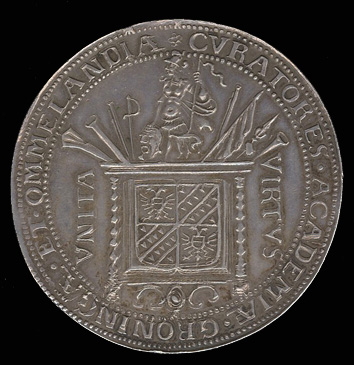
 0
0 -
Your idea is very good. I nevertheless keep my doubts that any mounting at all was ever used here. Even when the type of mounting you so clearly show is extremely carefully done, slight traces remain on the medal where the claws were in contact with its surfaces.
I am showing an over-contrasted view of the reverse. No trace whatsoever can be seen on it. I hope you can agree with me on this point. The obverse is quite identical.
The notion that a award should preferably be displayed comes much later, well into the XVIIIth century. We, modern collectors, have grown up with the picture of a "gong" hanging onto so kind of an attachment to be displayed. Awards did not have to be obvious to be appreciated. I believe the German word for a commemorative medal translate like " a token of thanks ". A medal.
On the other hands, orders of chivalry, were badges to show you BELONGED to a select group. An outward sign was normal.
Here is the picture. Very best regards
Veteran
Very interesting medal you have there!!Last week ( maybe two by now), I visited Het Loo and I recall there were some old medals from a similar time period as yours that had a mounting system that one still finds on necklaces today. This method will not damage the medal/coin at all so it would be hard to prove either way but it's something to consider...
Thanks for showing this great medal.
JC (Floor)
Here is a picture of what I was talking about..
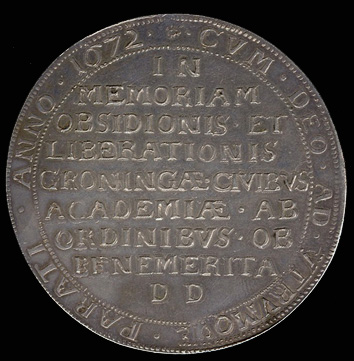
 0
0 -
Hello Paul
Thank you for your kind word about the medal. Yes, it looks quite beautiful and it is a pleasure to hold in ones' hand.
Careful scrutiny of the upper part shows no true evidence of soldering. The only variation is a slight "blob" in the striking of the obverse at right from upper center (11:45 o'clock). The rest of the rim is absolutely without the slightest trace of mounting on either sides.
To be frank, I really have my doubts that the idea of wearing it to a chain or a ribbon would have occured to anyone at the time.
Again, many thanks for your useful advice. Very best regards
Paul
0 -
A few weeks ago, I requested information about the medal awarded in 1672 to the students at the University of Groningen who defended the citY. Several members of this forum came up with excellent suggestions.
I was able to secure one at auction. It appears to be quite scarce (after all, it was given to only 120 men some 335 years ago !) and the classic book "Orders and Decorations of the Netherlands" by Meijer, Mulder & Wagenaar did not have one to show with their description of the medal. In view of this, I thought the members of the club might enjoy seeing it.
My grateful thanks to the fellow members who generously shared their knowledge and best regards to all.
Veteran
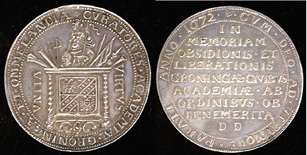
 0
0 -
This clasp was earned by all members of the French Forces during the 1939-40 campaign in France (Phoney War and May-June disaster). It also went to some Allied troups, such as the Polish Army in France.
Rather a sad clasp for those men to wear, but a number of them had fought well and deserved recognition.
Veteran
0 -
Thank you Jackie, for your tip. I found the book where I had seen the medal mentioned on the site you told me about. It confirms that it is one of the earlier awards for war services, which make me wonder even more if any are known to have survived.
Ed, I fully agree with your remark, which is fully justified when one thinks in terms of wearing medals. The very early official tokens of appreciation were close to monetary rewards, which in many cases were far more popular in those days than medals which did not have true cash value. The wearing of such awards was still an other question, since only orders were currently displayed from a ribbon or a chain. They nevertheless were awards. They were the ancestors of campaign medals to be worn with the uniform.
This is well demonstrated by the French life-saving medals which were officially established around 1810 by Napoleon Ist as non-wearable 40mm and larger silver and gold named medals. The official approach was even to give the person a choice between an official medal or a sum of money, ready cash in some cases being much more of a help to the person it went to. It was over 20 years later that King Louis-Philippe allowed formal wear of life-saving medals, the size of which was later adapted to this end.
In the case of the students of Groningen University, it may have been felt that a distinctive medal would be more in keeping with their statute as gentlemen. In which case the medal truly is an ancestor of modern awards for bravery and service.
Does the story say if other defenders of the City got monetary rewards for their parts in its defense?
I hope more about this medal will come up as time goes. Very best wishes to all
Veteran
This gets us into the whole complex era where table medals, often made and awarded simply for their intrinsic value (how much gold, how much silver) were mounted (officially or unofficially) and worn from chains or, later, ribbons. A fascinating transitional period, but we are never certain whether what we see is stuff for phaleristic or numismatic study.0 -
Hello everyone
I am trying to gather as much information as I possibly can on the medal supposed to have been given to 120 students at the University of Groningen who fought the Bishop of Munster when he put that city to siege in 1672.
Does anyone know if any of these medals have survived? It seems such a long time ago. If any have, they might well be among the oldest "campaign medals" in existence.
I have a faint recollection of having read something about them in a book on Dutch Orders & Decorations, but cannot remember which (would any one know?). A short notice was found on Google, giving some general information with a picture of the obverse of this silver non wearable medal.
Every bit of information will be gratefully received.
Best wishes to all
Veteran
0 -
Hello John
The duc d'Angoul?me, known after 1824 when his father became King of France as Charles X as the Dolphin was also :
Grand Cross of the Military Order of St.Louis
Grand Cross of the Legion of honor
Member of the Golden Fleece (Spain)
Grand Cross of the Order of Charles III (Spain)
Grand Cross of the Three United Orders (Portugal)
Member of the Order of the Black Eagle (Prussia)
Member of the Order of the Annunciata (Sardinia)
Member of the Order of the Crown of Rue (Saxony)
Grand Cross of the Order of Saint Ferdinand (Sicily)
all found in the 1828 issue of the "Almanach Royal".
....and possibly a few more
Since he was a member of the Holy Spirit, he automatically was also a member of the Order of Saint Michel (les Ordres du Roi)
Naturally most of these foreign Orders might have been "Ordres de Courteoisie" i.e. exchange awards among the Crowned Families.
I hope this helps. Best regards
Veteran
0 -
Hello Kepi blanc
Nice group and display you are showing here.. I was interested to see the "Certificat de bonne conduite" awarded to Leg. 1re Classe WITTIG, as it was signed by Colonel de Torquat de la Coulerie.
A very distinguished officer who was wounded a few meters from me at Enzvaihingen, in Wurtemberg, April 1945. He was then a captain in command of the 10th Company of the IIIrd Batallion of the Regiment de Marche de la Legion etrangere. I was his radio-operator.
He became a general and died a few years ago.
A moi, la Legion!
Veteran
0 -
Gentlemen
Am I right to assume that this badge of the Order of the Sword is different from the current issues? It is gold, weight 15grs, 55x39mm with the crown. the suspension ring being unsoldered and closed like a key-ring. The metal frame is quite thick, and the crown is attached to the cross by a horizontal hinge. It is beautifully made and one of the most stricking badges I have ever seen. No hallmark could be found.
My impression is that it could be XIXth century. Would anyone on this forum care to date it ?
Thank you
Veteran
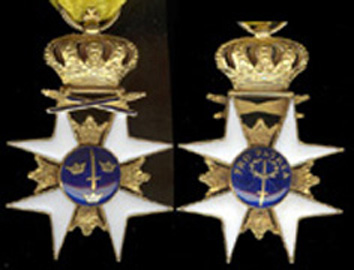
 0
0 -
Sorry I just noticed I made a mistake in the order of awards :
Legion d'honneur - Medaille militaire - Croix de guerre with BRONZE PALM on ribbon - French Victory Medal - French War Commemorative Medal - BWM with MID - Belgian Yser Medal.
This should be right
Veteran
0 -
This is for Dante
Wonderful story and excellent documents. This man was an engine-driver for the french railways; he never lived to see his awards. Should he have lived, his group would have been mounted as follows :
Chevalier Legion d'honneur - medaille militaire with BRONZE PALM on the ribbon - French Victory Medal - French War Commemorative Medal - BWM with MID - Belgian Medal for Ypres.
I rather agree that the group would have rather be displayed in rows of 3 - 3 - 1 or possibly 4 - 3.
This is an OUTSTANDING GROUP and I cannot remember seeing anything like it before. Thank you so much for bringing such a remarquable example of the nearly unknown importance of the BWM when awarded to foreigners.
Very best wishes
Veteran
0 -
Hello love4history
The picture I added to my recent message is the cover of the Register for the BWM kept by the British National Archives at Kew near London. I looked it up two years ago as I was researching a Belgian recipient of the BWM, which I found there.
It tells of many very brave people for whom this "current" medal was indeed the only recognition they received for extremely dangereous work, as the fate of this engine-driver clearly proves.
I hope this answers your question
Best regards
Veteran
0 -
Thank you very much. This is the first and only one I have ever seen, and I really neaded expert advice.
Very best regards
Veteran
0 -
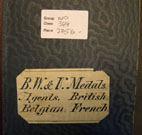 Good morning Dante
Good morning DanteThis group is VERY unusual. Am I right to assume that the BWM is named ? Could it be confirmed by the Roll at Kew? How about the Mention in dispaches?
The combination of awards is strange : Legion of honor + French military medal should normally go with a croix de guerre having at least one palm, and probably other devices as well. The military medal being the highest award for bravery to a non-commissioned fighter (and often only awarded after a series of previous mentions in dispaches), the Legion of honor would have to be awarded after he was promoted to commissioned rank or for further outstanding services after the Military medal (posthumeously ?).
The Victory Medal is the french type and would probably have been worn before the french WW1 Commemorative medal.
The story must certainly be interesting to read. Could we have more?
Thank you for showing this intriguing set of awards. The only explanation for the BWM may well have be, if confirmed, the award of a Mention in dispaches by the British, which would then make it more of a decoration in its own right than a commemorative medal.
Very best regards
Paul

 0
0 -
 Good morning Dante
Good morning DanteThis group is VERY unusual. Am I right to assume that the BWM is named ? Could it be confirmed by the Roll at Kew? How about the Mention in dispaches?
The combination of awards is strange : Legion of honor + French military medal should normally go with a croix de guerre having at least one palm, and probably other devices as well. The military medal being the highest award for bravery to a non-commissioned fighter (and often only awarded after a series of previous mentions in dispaches), the Legion of honor would have to be awarded after he was promoted to commissioned rank or for further outstanding services after the Military medal (posthumeously ?).
The Victory Medal is the french type and would probably have been worn before the french WW1 Commemorative medal.
The story must certainly be interesting to read. Could we have more?
Thank you for showing this intriguing set of awards. The only explanation for the BWM may well have be, if confirmed, the award of a Mention in dispaches by the British, which would then make it more of a decoration in its own right than a commemorative medal.
Very best regards
Paul
 0
0







restoration of medals
in Russia: Soviet Orders, Medals & Decorations
Posted
This is an interesting discussion, reflecting one of the precious aspects of our civilisation : freedom.
The various points made all make sense. They have their bit of truth. And collectors are welcome to their opinions when it comes to the medals and orders they bought to add to their collections.
Now, orders and medals were never made for collectors. They are awards meant to be displayed and worn by people who have earned them. So they get knock around, they slip through their owners fingers and pieces of enamel fly, they jingle on one another (you will know what I mean if you have worn full sized awards on parade). Would a general wear a crooked or badly chipped grand cross star in uniform? Probably not, he would have it repaired, as he would have his watch repaired if it needed.
In the same way, ribbons get dirty or their colours fade. They are replaced by their owners as need may be, just so that they will look their best. It's normal. A good soldier should look neat, his awards included.
Badges are jewels which are meant to look good. They should look good. Simply, if they need repair, they probably should be repaired by a jeweler who knows his trade. If a collector has a very good enameled piece which needs help, he will be acting as the owner would have when he has it fixed. OK, it's a genuine medal which has been repaired. Let's not forget the only way to have absolutely perfect orders and medals to collect is to pick only badges that have never left their presentation cases... which is not much history to tell.
A beautiful repair job on an order that needs and deserves it is a compliment to a witness of the past. That is also what they do in museums. But if you cannot provide expert repair, the award would be better of as it is.
Now every one is intitled to a cut-and-dry opinion on the subject. We are free to have it.
Very best regards to all
Veteran